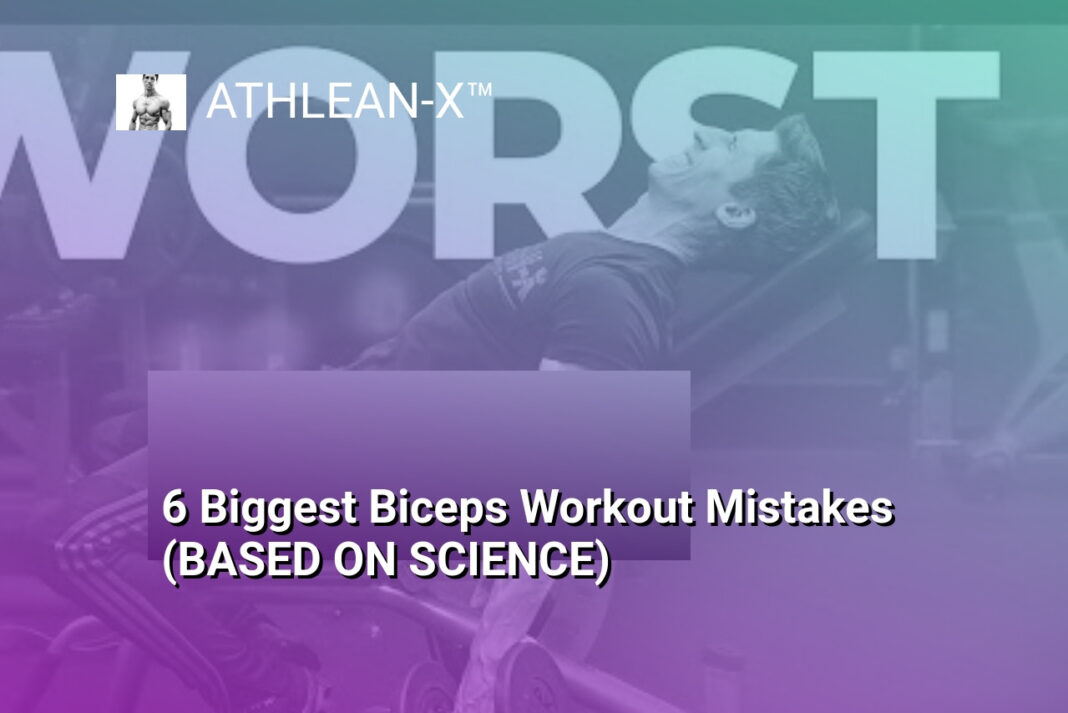The Bottom Line:
- The video discusses and ranks the best and worst triceps exercises for muscle growth, considering factors such as tension, feel, and progression.
- The overhead cable triceps extension is highlighted as the best exercise, as it effectively targets the long head of the triceps and provides high tension in the stretched position.
- The reverse grip press down is considered the worst option, as it limits strength output and may not be worth the reduction in overload potential.
- The video also covers other exercises like the bar press down, dumbbell French press, and Skull Crushers, analyzing their strengths and weaknesses.
- The overall goal is to identify exercises that meet three criteria: high tension, good feel, and simple progression, ensuring proportional triceps development.
The Pressdown Variations
Overhead Cable Triceps Extensions
The overhead cable triceps extension is a unique variation that sets it apart from the standard pressdown. The key difference lies in the arm position – instead of keeping the arms down by the sides, the overhead extension requires moving the arms up overhead. This subtle change has a profound impact on the muscle activation, particularly for the long head of the triceps.
The long head of the triceps is the only head that crosses both the elbow and shoulder joints. While all three triceps heads work to straighten the elbow, the long head also plays a role in shoulder extension, or the movement of the arm down from an overhead position. By lifting the arms overhead, the long head is placed under a greater stretch, allowing for increased tension and contraction during the exercise.
Studies have shown that the overhead cable extension can stimulate around 40% more triceps growth compared to the traditional pressdown. This is likely due to the enhanced activation of the long head in its lengthened position. The cable resistance also provides high tension throughout the full range of motion, further challenging the triceps musculature.
Dumbbell French Press Variations
The dumbbell French press is another effective option for targeting the triceps, particularly the long head. Performing this exercise seated can help improve stability and allow the lifter to focus the tension directly on the triceps, rather than having to manage the dumbbell’s momentum.
One potential downside of the dumbbell French press is the circular resistance path, which means the triceps experience greater tension at the bottom of the movement and less at the top. However, the stretched position of the long head at the top may be the more important factor for muscle growth, so this is not necessarily a dealbreaker.
Some lifters find the size and unwieldiness of heavy dumbbells to be a limiting factor as their triceps strength increases. Performing the exercise one arm at a time can help mitigate this issue, as the dumbbell will be less bulky and awkward to handle.
Skull Crushers and Variations
Skull crushers, also known as lying triceps extensions, are a staple triceps-building exercise. They offer high tension on the triceps, especially when the elbows are arched back behind the head rather than stopping at the “skull” position.
The use of an EZ-bar or other cambered bar can help alleviate any unwanted strain on the wrists during skull crushers. Additionally, starting the movement with the elbows slightly back rather than straight up can help ensure more uniform tension throughout the range of motion.
Many lifters consider skull crushers to be their favorite free-weight triceps exercise, as they allow for effective overloading and a satisfying contraction. When performed with proper technique, skull crushers can be a highly effective addition to any triceps-focused routine.
The Overhead Cable Triceps Extension
Emphasizing the Long Head: The Overhead Cable Triceps Extension
The overhead cable triceps extension is a unique exercise that sets itself apart from the traditional press down by specifically targeting the long head of the triceps. This is a crucial distinction, as the long head is the only head of the triceps that crosses both the elbow and shoulder joints.
When performing the overhead cable triceps extension, the arms are moved up overhead, placing the long head of the triceps in a stretched position. This increased stretch on the long head is believed to be a key factor in driving muscle growth. Studies have shown that the overhead extension can stimulate up to 40% more triceps growth compared to the standard press down.
The cable attachment also provides constant tension on the triceps throughout the entire range of motion, ensuring that the muscles are under high stress even in the stretched position. This combination of stretch and tension is a potent stimulus for muscle hypertrophy.
Rope vs. Bar: Choosing the Right Attachment
While the overhead cable triceps extension can be performed with either a rope or a straight bar attachment, there are some subtle differences to consider. The rope version may provide a more pronounced mind-muscle connection, as the user can focus on driving the handles apart at the bottom of the movement.
However, the straight bar attachment offers a more stable and rigid setup, allowing for greater load and overload potential. In a personal experiment, the researcher found that they were able to perform 4 more reps with the bar compared to the rope, while keeping the weight the same.
Ultimately, both variations can be effective, but the bar version may be the preferred choice for those seeking maximum muscle growth and strength development.
Addressing Imbalances with the Katana Triceps Extension
Another unique overhead triceps exercise is the katana triceps extension. This movement involves crossing the arms overhead while holding the opposite side’s cable, creating a unique arm position that targets the triceps in a slightly different way.
One of the key benefits of the katana extension is its ability to address left-right imbalances. By working each arm individually, users can identify and address any strength or muscle mass discrepancies between the two sides.
Additionally, the scapular plane position, with the arms angled slightly forward, can feel more comfortable and natural for some individuals. This variation may be a valuable addition to a triceps training program, especially for those looking to improve symmetry and balance in the upper arms.
The Katana Triceps Extension
The Versatility of the Katana Triceps Extension
The Katana Triceps Extension is a unique and dynamic exercise that offers several benefits for targeting the triceps muscles. This movement, named after the graceful motion of drawing a Japanese katana sword, involves crossing your arms overhead while grasping the opposite side’s cable.
Efficient Bilateral Training
One of the key advantages of the Katana Triceps Extension is its ability to work both arms simultaneously, saving time and addressing any left-right imbalances. By starting with the cables at around waist height and then spinning 180 degrees while crossing your arms, you can effectively target the triceps on each side without the need for additional setup.
Optimal Muscle Engagement
The Katana Triceps Extension places the arms in a 30-40 degree forward position, known as the scapular plane. This angle feels comfortable for many individuals and helps to ensure optimal muscle engagement throughout the exercise. The cable resistance provides a consistent and challenging load, allowing you to focus on maintaining proper form and technique.
While the Katana Triceps Extension may require a bit more setup compared to some other triceps exercises, the benefits it offers make it a valuable addition to any well-rounded strength training program. The ability to target both arms simultaneously, the comfortable scapular plane positioning, and the consistent cable resistance all contribute to the exercise’s effectiveness in promoting triceps muscle growth and development.
The Dumbbell French Press
Exploring the Dumbbell French Press
The dumbbell French press is a versatile triceps exercise that can be a great addition to your workout routine. One of the key advantages of this movement is its ability to target the long head of the triceps, which is crucial for achieving a well-rounded and proportional arm development.
Maximizing Triceps Engagement
When performing the dumbbell French press, it’s important to focus on maintaining proper form and technique. Doing these exercises seated can help you stay more stable, allowing you to direct the tension directly to the triceps rather than having to compensate for balance. This stability can be particularly beneficial as the weight of the dumbbell increases, preventing unwanted strain on the wrists.
Balancing Resistance and Comfort
One potential drawback of the dumbbell French press is that as your triceps get stronger, the size and bulk of the dumbbells can become unwieldy and challenging to handle. This can sometimes lead to discomfort or strain in the wrists. To mitigate this issue, you can consider performing the exercise one arm at a time, which can provide a more comfortable and controlled movement pattern.
While the dumbbell French press may not offer the same smooth and uniform tension as cable-based exercises, it still remains a valuable addition to any triceps-focused workout routine. The ability to target the long head of the triceps and the potential for progressive overload make this exercise a solid choice for those seeking to build and sculpt their arm musculature.
The Skull Crusher
Mastering the Skull Crusher: Unleashing Triceps Might
The Skull Crusher, a staple in the arsenal of any serious lifter, is a true powerhouse when it comes to targeting and building the triceps. This exercise offers an unparalleled combination of high tension, smooth resistance, and the ability to progressively overload, making it a must-include in any well-rounded triceps training regimen.
One of the key advantages of the Skull Crusher is the way it places the triceps under significant stretch, particularly if you opt for an arched bar path that takes the weight behind your head rather than stopping at your skull. This extended range of motion not only challenges the muscle but also taps into the long head of the triceps, which is crucial for achieving that coveted horseshoe shape.
Moreover, the Skull Crusher’s ability to be easily loaded with additional weight or reps from week to week makes it an excellent choice for those seeking to continually challenge and grow their triceps. Whether you opt for a straight bar or an EZ-bar variation, the Skull Crusher provides a stable, controlled environment that allows you to focus on the task at hand – building bigger, stronger triceps.
While some may find the Skull Crusher slightly less smooth in its resistance profile compared to cable-based exercises, this can be mitigated by starting the movement with your elbows slightly behind your body, immediately engaging the triceps before arching the weight back. This small adjustment helps to ensure a more uniform tension throughout the range of motion.
In the end, the Skull Crusher’s combination of high tension, stretch, and progressive overload potential make it a true standout in the world of triceps exercises. For those seeking to maximize their triceps development, the Skull Crusher is an absolute must-include in their training arsenal.
Unlocking the Long Head: The Overhead Cable Extension
Another exercise that deserves a spot in the S-tier of triceps exercises is the overhead cable extension. This movement, which involves extending the arms overhead while keeping the elbows fixed, is a game-changer when it comes to targeting the long head of the triceps.
The unique positioning of the arms overhead places the long head of the triceps in a highly stretched position, allowing for maximal tension and stimulation of this crucial muscle group. Furthermore, the cable resistance provides a constant, uniform challenge throughout the entire range of motion, ensuring that the triceps are under tension from start to finish.
Recent research has even shown that overhead extensions can elicit up to 40% more triceps growth compared to traditional pushdowns, highlighting the importance of this exercise in any serious triceps-building program.
Whether you opt for a straight bar or a rope attachment, the overhead cable extension is a must-include in your triceps training routine. Its ability to target the long head, combined with the high-tension, stretch-focused nature of the movement, make it a true standout in the world of triceps exercises.
Addressing Imbalances: The Katana Triceps Extension
The Katana triceps extension, named for its resemblance to the drawing of a pair of Japanese swords, is a unique and highly effective exercise that deserves a spot in the A-tier of triceps exercises. This movement not only targets the triceps with high tension and stretch but also offers the added benefit of addressing any left-right imbalances that may be present.
By having each arm work independently while still saving on time by completing both sides simultaneously, the Katana extension allows you to identify and correct any muscular imbalances that may have developed over time. This can be particularly beneficial for those who have experienced uneven growth or strength in their triceps.
While the Katana extension does require a bit more setup and can have a slight learning curve, the benefits it offers make it a worthwhile inclusion in any serious lifter’s training program. The scapular plane positioning, which places the arms in a 30-40 degree forward angle, also helps to create a comfortable and biomechanically efficient movement pattern.
For those seeking to build balanced, proportional triceps development, the Katana triceps extension is a must-try exercise that can help take your arm training to the next level.





